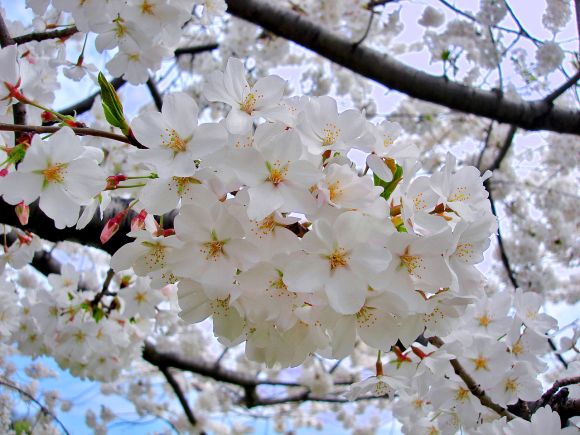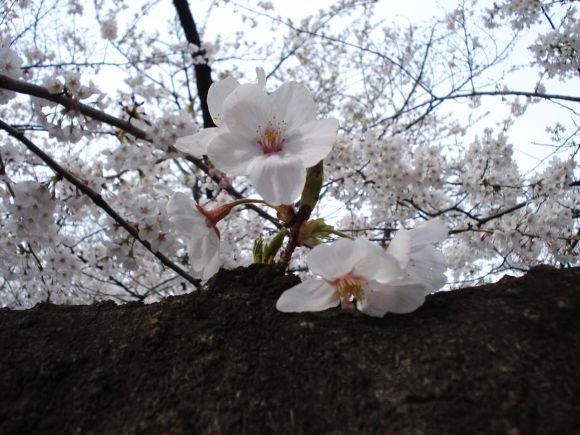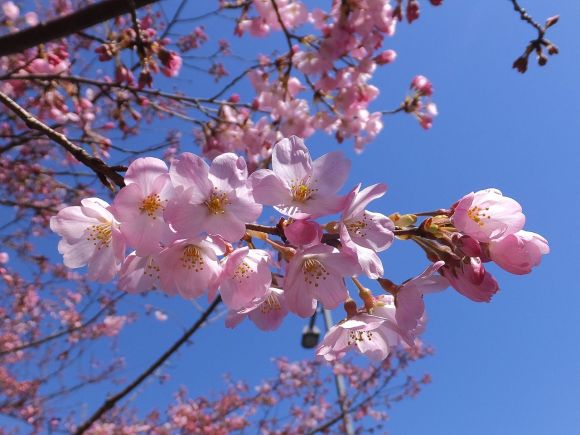
It’s that time of year again, when the cold of winter fades away and gives birth to the beautiful pink and white hues of cherry blossoms contrasted against their trees’ elegant dark branches. It’s a season long identified with Japanese culture around the world.
However, news organizations in South Korea are declaring that this has gone on long enough and are calling for a concerted effort to let everyone know once and for all that cherry blossoms are theirs.
■ Would a cherry tree by any other name smell as confusing?
This isn’t the first year the debate of cherry blossom ownership has been raised. The species in question is known as the King cherry (wangbeojnamu) in Korea and Yoshino cherry (somei Yoshino) in Japan. The even have nearly identical scientific names of Prunus Yedoensis and Prunus x Yedoensis respectively.
Those formal names likely stick in the craw of Koreans as it was assigned by Japanese botanist Ninzo Matsumura after the Edo (Tokyo) region of Japan without any substantial proof of the actual native habitat of the species.
Although there has been no definitive proof either way regarding the true home of these trees they are basically considered unique species with the King cherry originating from Jeju Island in South Korea while the Yoshino cherry is a hybrid of the King cherry but genetically distinct and native to Japan.

■ “Backed by Science”
This year’s claims by the media of pretty cherry trees having a home in Korea is said to have gotten highly credible backing by the Korean Forest Research Institute who have accumulated studies from both sides and found that the evidence supporting a Korean origin far outnumbered any evidence for Japan.
In addition, DNA found in the cherry trees given to Washington D.C. By Japan was reported to be linked to Jeju Island trees. The Institute has also found over 100 Yoshino cherry trees that they feel are native to Jeju Island based on their locations and surrounding plant-life.

■ Reaction
Naturally, considering Japan and Korea’s often tumultuous relationship the debate of what nation is the source of cherry blossoms stirs emotions on both sides. Here’s what Japanese netizens had to say.
“Here we go again…”
“So what if the cherry blossoms originated in Korea? Do they want a reward?”
“Yes, yes, they all come from Korea. We get it. What else?”
“Oh hey it’s spring!”
Meanwhile in Korea, readers of these newly galvanized claims of cherry blossom ownership reacted with an equally bored demeanor.
“There areas are so close geographically, there isn’t much point in arguing it.”
“Cherry blossoms are cherry blossoms. No need to ruin them with nationalism.”
“It’s still not proven yet?”
“In the spring Japan enjoys their modified cherry blossoms while Korea enjoys their pure cherry blossoms. Let’s just all enjoy the flowers and not waste unnecessary emotional energy.”
That last comment seems to have very nicely summed up the feeling of regular people in both countries: the flowers are pretty so who cares where they come from?

That being said, I could sympathize with Korea if the blossoms truly were native to their land but instead are deeply connected to another country. However, going around citing research and DNA analysis likely won’t win anyone over to their side.
No, the real solution would be to throw some truly legendary cherry blossom viewing parties so that the world takes notice and wants to be in Korea when those pink buds open up. With enough time and kick-ass events Korea could conceivably appropriate (or reappropriate) this culture from Japan.
Right, so that should effectively throw down the party gauntlet. Let’s all have a great cherry blossom season and may the most fun nation win!
Source: Searchina, Focus Asia, Hamusoku (Japanese) Science Direct (English)
Top Image: RocketNews24

 Sakura season officially starts in Tokyo as cherry blossoms begin blooming in the capital
Sakura season officially starts in Tokyo as cherry blossoms begin blooming in the capital Space sakura have returned to Earth with cherry blossom superpowers
Space sakura have returned to Earth with cherry blossom superpowers Japanese weather site reveals the secret to knowing when a sakura cherry blossom will fall
Japanese weather site reveals the secret to knowing when a sakura cherry blossom will fall Sakura in Japan 2019: The best spots for hanami cherry blossom viewing
Sakura in Japan 2019: The best spots for hanami cherry blossom viewing Sakura 2017: Japan Meteorological Corporation releases first national cherry blossom forecast
Sakura 2017: Japan Meteorological Corporation releases first national cherry blossom forecast Rakuten randomly offers 58 New Year’s osechi feasts in Japan, but did we get a star or a dud?
Rakuten randomly offers 58 New Year’s osechi feasts in Japan, but did we get a star or a dud? Japanese beef bowl chain Sukiya’s 2026 Smile Box lucky bag basically pays for itself
Japanese beef bowl chain Sukiya’s 2026 Smile Box lucky bag basically pays for itself First Kit Kat Chocolatery shop with cafe opens in Kyoto! New Chocolatery items released too
First Kit Kat Chocolatery shop with cafe opens in Kyoto! New Chocolatery items released too 7 great places to see Mt. Fuji from without having to climb it
7 great places to see Mt. Fuji from without having to climb it 7-Eleven Japan has a hack for creating insanely delicious potato chip rice meals
7-Eleven Japan has a hack for creating insanely delicious potato chip rice meals Stamina-destroying “Paralysis Noodles” are Tokyo’s newest over-the-top ramen innovation
Stamina-destroying “Paralysis Noodles” are Tokyo’s newest over-the-top ramen innovation Will whiskey aged in space taste smoother? Suntory is set to experiment this month
Will whiskey aged in space taste smoother? Suntory is set to experiment this month Japanese Joe Biden tries the Biden Burger in Japan
Japanese Joe Biden tries the Biden Burger in Japan Find out how lucky you’ll be in the Year of the Dog with this witty online fortune teller
Find out how lucky you’ll be in the Year of the Dog with this witty online fortune teller New Studio Ghibli exhibition brings anime movie magic to cities around Japan
New Studio Ghibli exhibition brings anime movie magic to cities around Japan Starbucks Japan ready to get Year of the Horse started with adorable drinkware and plushies【Pics】
Starbucks Japan ready to get Year of the Horse started with adorable drinkware and plushies【Pics】 Hayao Miyazaki says Happy New Year to Studio Ghibli fans with new art for Year of the Horse
Hayao Miyazaki says Happy New Year to Studio Ghibli fans with new art for Year of the Horse We found possibly the quietest Japanese-style hotel in Tokyo’s bustling Shinjuku district
We found possibly the quietest Japanese-style hotel in Tokyo’s bustling Shinjuku district Cup Noodle tries an authentic Jiro-style ramen, but something’s not quite right
Cup Noodle tries an authentic Jiro-style ramen, but something’s not quite right The best Starbucks Japan Frappuccinos we want to drink again in 2026
The best Starbucks Japan Frappuccinos we want to drink again in 2026 We revisited Sweets Paradise after a decade to see if Japan’s dessert buffet still delivers
We revisited Sweets Paradise after a decade to see if Japan’s dessert buffet still delivers That time Seiji called JASRAC to ask why he didn’t get paid royalties for his song being on TV
That time Seiji called JASRAC to ask why he didn’t get paid royalties for his song being on TV Japan’s oldest largetooth sawfish in captivity back on display in Mie Prefecture
Japan’s oldest largetooth sawfish in captivity back on display in Mie Prefecture Pizza Hut Japan’s hot lucky bags are perfect for a New Year’s pizza party
Pizza Hut Japan’s hot lucky bags are perfect for a New Year’s pizza party 7-Eleven Japan starts new temporary luggage storage service in over 300 branches
7-Eleven Japan starts new temporary luggage storage service in over 300 branches Disillusionment at Tsukiji’s tourist-target prices led us to a great ramen restaurant in Tokyo
Disillusionment at Tsukiji’s tourist-target prices led us to a great ramen restaurant in Tokyo Starbucks teams up with 166-year-old Kyoto doll maker for Year of the Horse decorations【Photos】
Starbucks teams up with 166-year-old Kyoto doll maker for Year of the Horse decorations【Photos】 Tokyo considering law requiring more trash cans following litter increase in heavily touristed area
Tokyo considering law requiring more trash cans following litter increase in heavily touristed area Tokyo’s Tsukiji sushi neighborhood asks tour groups to stay away for the rest of the month
Tokyo’s Tsukiji sushi neighborhood asks tour groups to stay away for the rest of the month Tokyo event lets you travel back in time, for free, to celebrate 100 years since Showa era start
Tokyo event lets you travel back in time, for free, to celebrate 100 years since Showa era start Japan may add Japanese language proficiency, lifestyle classes to permanent foreign resident requirements
Japan may add Japanese language proficiency, lifestyle classes to permanent foreign resident requirements Sanrio theme park in Japan announces plans to expand into a Sanrio resort
Sanrio theme park in Japan announces plans to expand into a Sanrio resort Survey asks foreign tourists what bothered them in Japan, more than half gave same answer
Survey asks foreign tourists what bothered them in Japan, more than half gave same answer Japan’s human washing machines will go on sale to general public, demos to be held in Tokyo
Japan’s human washing machines will go on sale to general public, demos to be held in Tokyo Japan’s deadliest food claims more victims, but why do people keep eating it for New Year’s?
Japan’s deadliest food claims more victims, but why do people keep eating it for New Year’s? We deeply regret going into this tunnel on our walk in the mountains of Japan
We deeply regret going into this tunnel on our walk in the mountains of Japan Studio Ghibli releases Kodama forest spirits from Princess Mononoke to light up your home
Studio Ghibli releases Kodama forest spirits from Princess Mononoke to light up your home Major Japanese hotel chain says reservations via overseas booking sites may not be valid
Major Japanese hotel chain says reservations via overseas booking sites may not be valid Put sesame oil in your coffee? Japanese maker says it’s the best way to start your day【Taste test】
Put sesame oil in your coffee? Japanese maker says it’s the best way to start your day【Taste test】 No more using real katana for tourism activities, Japan’s National Police Agency says
No more using real katana for tourism activities, Japan’s National Police Agency says Starbucks Japan reveals new sakura drinkware collection, inspired by evening cherry blossoms
Starbucks Japan reveals new sakura drinkware collection, inspired by evening cherry blossoms Updated cherry blossom forecast shows extra-long sakura season for Japan this year
Updated cherry blossom forecast shows extra-long sakura season for Japan this year Early-blooming sakura cherry blossoms create pink-tinged wonderlands in Japan
Early-blooming sakura cherry blossoms create pink-tinged wonderlands in Japan Green cherry blossoms blooming now across Japan
Green cherry blossoms blooming now across Japan Sakura begin to bloom in Japan as early cherry blossom season forecast for 2020
Sakura begin to bloom in Japan as early cherry blossom season forecast for 2020 Beautiful cherry blossom-shaped Japanese pencils have a special surprise when sharpened
Beautiful cherry blossom-shaped Japanese pencils have a special surprise when sharpened Sakura 2017: The best places to see cherry blossoms in Japan
Sakura 2017: The best places to see cherry blossoms in Japan Sakura season officially begins in Tokyo as cherry blossoms bloom at Yasukuni Shrine
Sakura season officially begins in Tokyo as cherry blossoms bloom at Yasukuni Shrine Spring snow falls in Tokyo, creating beautiful images of Japanese sakura cherry blossoms
Spring snow falls in Tokyo, creating beautiful images of Japanese sakura cherry blossoms Sakura report 2019: First cherry blossoms begin to bloom in Tokyo
Sakura report 2019: First cherry blossoms begin to bloom in Tokyo Cherry blossom forecast 2020 released! Sakura season shifts to new start time in Tokyo this year
Cherry blossom forecast 2020 released! Sakura season shifts to new start time in Tokyo this year Japan’s top 10 open-air hot spring baths with cherry blossom views【Survey】
Japan’s top 10 open-air hot spring baths with cherry blossom views【Survey】 Central Japan’s most famous cherry blossom spot now has sakura helicopter sky cruises
Central Japan’s most famous cherry blossom spot now has sakura helicopter sky cruises Sakura season 2018 officially declared in Tokyo as first cherry blossoms begin to bloom
Sakura season 2018 officially declared in Tokyo as first cherry blossoms begin to bloom Japan’s cherry blossom forecast for 2023 is here! Tokyo among cities to see sakura first
Japan’s cherry blossom forecast for 2023 is here! Tokyo among cities to see sakura first Sakura Skytree photos take Tokyo’s breath away, give kick-start to cherry blossom season【Photos】
Sakura Skytree photos take Tokyo’s breath away, give kick-start to cherry blossom season【Photos】 Cherry blossoms are going to bloom on Tokyo’s new license plates
Cherry blossoms are going to bloom on Tokyo’s new license plates
Leave a Reply